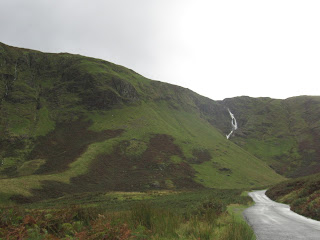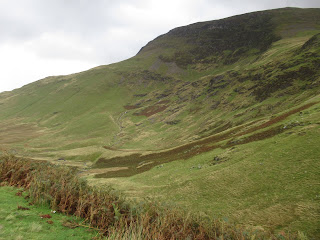After hightailing it from Conwy, a picture perfect town in north Wales where we'd spent the previous two nights, to Liverpool for the thoroughly enjoyable Magical Mystery Bus tour of Beatles' sights, we arrived mid afternoon in northwest England's Lake District. My English-born and raised mother went to teachers' college in the district's town of Ambleside in the late 1930s before emigrating to Canada as a war bride in 1945.
Given our very limited time, we figured the best way to tour part of the 30-mile long by 30-mile wide Lake District made famous by William Wordsworth poetry was to follow travel writer Rick Steves' Scenic Circle Drive that began in Keswick. As the drive would take us only through the North Lake District, we'd have to hope and see the southern area another time. The drive took us through the Newland Valley that was dotted with 500-year-old family-owned farms.
The hostel next to the mine was built in the 1920s to house miners.
Because it was getting so late in the day, we had no time to enjoy one of Cumbria's most photographed and popular lakes, Derwentwater, located just southwest of Keswick. Taking one of the cruises around the lake or the much more energetic nine-mile hike around the lake would have to wait. IF we're ever lucky enough to come back to this magical part of Britain, I hope we can then take the time to take in so much more of the Lake District as we left with just an appreciation of the magical area.
We started in the charming town of Keswick that was an important mining center for copper, lead and slate through the Middle Ages and then became a resort in the 19th century when people first began "communing with nature."
Just outside of Keswick was the Castlerigg Stone Circle located in the county of Cumbria, home to seventy percent of England's stone circles. Mysteriously laid out on a line between the two tallest peaks on the horizon were 38 stones that served as a celestial calendar for ritual celebrations. How the sun rose and set in relation to the stones determined festival dates.
Castlerigg was one of the first archaeological sites in England to be placed under the care of the National Trust because of concerns of numerous public and mineral railways and development of lakeshore land.
These two front stones faced due north toward a cut in the mountains.
Even in the afternoon drizzle, it was fascinating being there imagining ancient people gathering in the clearing in springtime to celebrate fertility or commemorating the harvest in the fall.
Castlerigg's Stone Circle popularity increased after the arrival of the railway in Keswick which brought day trippers from the industrial north. Concerns regarding its care and protection were soon expressed, partially as a reaction to visitors breaking off fragments from the stones as souvenirs. In response to this threat, Castlerigg became one of the few prehistoric monuments to be protected by law in 1992.
In 2017, the Lake District was designated as a World Heritage site because its landscape was of exceptional beauty, it was an inspiration for artistic and literary movements, and its landscape was the catalyst for key developments in the national and international protection of landscapes.
I felt badly for Steven having to drive on the one-lane road because there were only occasional turnouts to allow for cars to pass.
I made sure not to ooh and aah too much as I didn't want Steven to take his eyes off the road and admire the bucolic views even if the weather wasn't ideal.
We drove toward the summit of Newlands Pass that was 1093 feet high.
If we'd had more time, we would have loved to hike to the Moss Force Waterfall at the summit but our whistle stop tour didn't allow for that! There was also another hike up to Knott Rigg that Steves wrote offered "more TPCB" or thrills per calorie burned than any walk in the region. That, too, would have to be put in our Future Trips file!
The summit:
From the summit, we descended to Buttermere. Lots of place names in the district ended in 'mere' which was related to the German word for lake, meer. The road was a 25% grade so very steep and again extremely narrow. We were very thankful that there was very little traffic.
The scenic lake outside of the hamlet of Buttermere:
The village church:
Another view of Buttermere Lake:
The stone walls reminded us of those we loved seeing in Kentucky's horse country.
I was surprised we didn't see more sheep than this lone one.
Guess I spoke too soon as we began climbing the rugged Honister Pass! These shaggy animals that almost looked more like goats were Swaledale sheep.
Soon we noticed the hills were strewn with glacial debris and remnants of the area's old slate mines.
At the summit of Honister Pass was the Honister Slate Mine, the country's last still-functioning mine. A few days previously, Steven and I had spent a chunk of time at the interesting National Slate Museum in Llanberis, Wales, and saw another nearby slate mine. I'd hoped to take a tour of that one and would have loved to go deep in the mountain here to learn of the hardships of the miners' lives and how "green gold" was once again trendy. But, due to how much we'd already crammed into the day and still had a good distance to travel, that was impossible.
Luckily, we did have enough time to spend a few minutes at the souvenir shop!
A different type of sheep greeted us after we left the mine on the way to Bowder Stone.
This narrow point of the valley was christened the Jaws of Borrowdale by intrepid 18th century writers who came to admire the wild and dramatic scenery. The Bowder (boulder) Stone itself was turned into a tourist attraction in the 1780s. Debate continues over whether the stone was left here by a melting glacier or whether it fell from the mountains above. The pioneers of traditional rock climbing cut their teeth on the crags.
After spending so much time in the car since leaving Wales that morning, we decided to get some much needed exercise and detoured toward the house-sized rock.
Atop Bowder Stone:
The view from the Stone:
It was 6 before we left Keswick to drive another 75 miles north to Hexham, our destination to hike along Hadrian's Wall the next day. Fortunately, we'd reserved and reconfirmed our reservation at a B&B in Hexham knowing we'd be arriving so late. Unfortunately, however, once we arrived there was no one at the inn and no response to our phone calls which was tough after such a long and tiring day. Thank goodness we let our fingers do the walking and were able to find another abode for the night!
Next post: Hiking the aforementioned Hadrian's Wall in the rain!
I am also writing posts of our recent very short trip to Sri Lanka and India that was supposed to have been part of an extended four-month trip to much more of Asia and the Middle East. Here's a link to the most recent post about our train trip to Kandy and the thrilling fire eating and fire walking performance our first night:
Posted on April 6th, 2020, from a sunny and cloud-free day in Denver. Please make sure to take care of yourself and each other in these troubled times.









































































I liked the "Swaledale sheep", wonder what kind of wool/yarn they would make. It takes a lot of rain to make the hills and valleys so green. And you sure had it. LIl Red
ReplyDeleteWe sure did have plenty of rain, Lil Red, but the result was the lush hills and valleys in the Lake District as you pointed out.
ReplyDeleteXOXO,
Annie